13 Unexpected Ways To Use Orange Juice

Orange juice is such a familiar staple of the breakfast table that, for many, its very presence symbolizes a wholesome, picture-perfect start to a productive day. Americans drink nearly 2.5 gallons of it per person every year, which is a lot considering many of us are in too much of a hurry to do more than grab a cup of coffee and the keys before rushing out the door. Packed with vitamin C as well as a significant dose of sugar, the vibrantly-hued drink is the perfect accompaniment to a variety of breakfasts, where its sweetness helps to balance the saltiness of bacon, while its acidity cuts through carb-heavy pancakes.
Yet orange juice is also one of those items that might end up neglected in your fridge door. A little goes a long way (one cup can contain a whopping 21 grams of sugar), and you might simply prefer coffee or a smoothie some mornings. While this may seem like a good reason to stop buying the juice altogether, don't be too hasty. There's no rule dictating that it has to be relegated to the breakfast table. There are many reasons why it shouldn't be stuck there. Several cocktails use it, including mimosas and tequila sunrises, and it can make a transformational addition to marinades and salad dressings.
When you want something even more outside the box, however, we've got plenty of options for you. From hot, creamy drinks to a sophisticated raw seafood dish, here are some of the best and most unexpected ways to use orange juice.
Read more: Ingredients To Take Your Scrambled Eggs To The Next Level
Make Overnight Oats
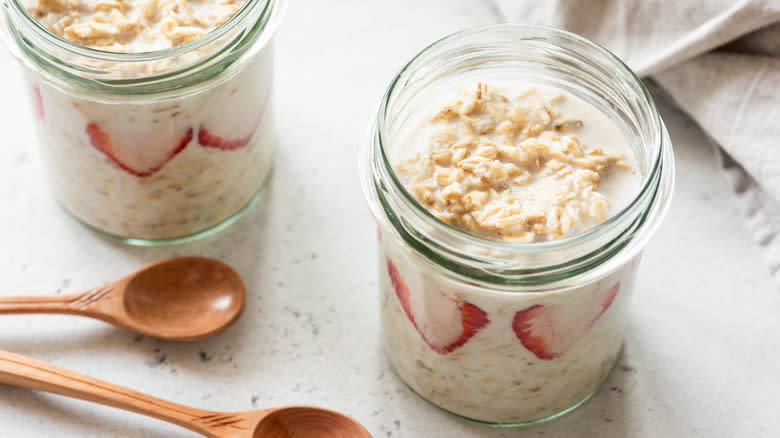
With a little bit of planning, you can have a readymade dessert for breakfast waiting for you when you start the day. Overnight oats are the perfect option for anyone who likes breakfast but is not a morning person, as they are a healthy, grab-and-go option that you can prep the night before. All you have to do is combine oats, chia seeds, and liquid , then let the mixture sit in the fridge overnight. When you wake up, the oats and seeds will have absorbed the moisture and taken on a texture similar to rice pudding.
You can make overnight oats with practically any ingredients you want. You could stick to a simple combination of oats, chia seeds, milk (dairy or plant-based), and honey as a sweetener, or you could get creative by adding nuts, fresh or dried fruit, and coconut flakes. Another option is to change up the liquid, in which case, orange juice is an obvious choice. Not only does it provide a familiar citrus flavor, but it also doubles as a sweetener. Keep in mind that, because orange juice has practically no fat, it will produce a less creamy texture than if you used milk. Check out our chocolate orange overnight oats recipe if you're a fan of cocoa-forward flavors. To have the best of both worlds, use half milk and half orange juice, or add a few spoonfuls of yogurt.
Make A Cuban Sandwich

A classic Cuban sandwich contains ham, roasted pork, Swiss cheese, pickles, and mustard pressed between slices of Cuban bread. In Tampa, it also often contains salami, adding another layer of salty, meaty flavor. The allure of the Cuban sandwich goes far beyond its basic components, which might first give the impression that it's nothing more than a glorified version of ham and cheese. Yet, much like the Philly cheesesteak, it is a decadent source of regional pride with the flavor to back it up. The toasted bread, acidic pickles, and layer upon layer of salty meat constitute a perfected formula, to the point where eating one is mandatory whenever you happen to be in Florida.
One of the reasons Cuban sandwiches are so beloved is that they are not made with just any old cold cuts. In fact, the preparation of the meat is where the magic happens -- and this is where the orange juice comes in. The roasted pork must be marinated to provide the knockout flavor that is emblematic of the sandwich, and while there are many options in this regard, citrus-based mojo sauce is a favorite. Our Cuban sandwich recipe uses orange juice with Sazon Goya (a salty, garlicky spice mix), cilantro, olive oil, lime juice, and garlic to create a vibrant flavor that suffuses the entire sandwich and is worth every minute of its preparation.
Add It To Donuts And Fritters
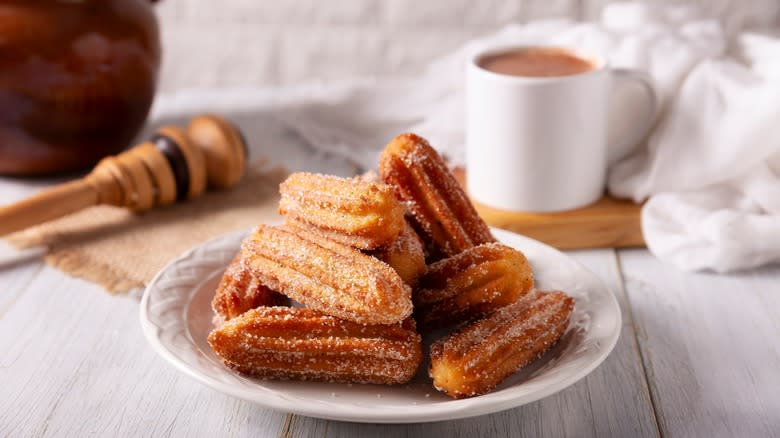
Just when you thought donuts couldn't get more delicious, we have a simple way to upgrade them that will also help get rid of that pesky carton of OJ that's been sitting in your fridge for far too long. The thought of making donuts at home can be intimidating given that they usually require yeast and frying -- two culinary factors that are challenging individually let alone in combination. But once you get going, it's a surprisingly straightforward process.
For one, a standard donut recipe is pretty simple, containing little more than flour, sugar, butter, milk, eggs, yeast, and salt to produce sweet, buttery, yeasty rings of deliciousness. To add a little more flavor, people may fill them with jelly, lemon curd, and chocolate, but adding orange juice to the batter (as we do in our old-fashioned apple fritter recipe) or to the classic sugar glaze, is much easier and more surprising. The sharp citrus tang of the juice is an excellent counterweight to the sugar, which can easily dominate donut recipes and lead to disappointingly forgettable results. If you're a first-time donut maker and want to produce something above average without biting off more than you can chew, this is an ideal way to stand out.
Zest Up Your Hot Chocolate

Whether you're chasing away the cold on a winter's day or need some coziness on a slow weekend, hot chocolate is the cure to many an ailment. Sweet, warm, and creamy, it's a source of comfort for adults and kids alike. You might have a favorite store-bought powdered mix or a recipe you turn to again and again, but we think that adding orange juice might become a new part of your tried-and-true formula as soon as you try it.
For centuries, the Aztecs added chiles and vanilla to their bitter, unsweetened precursor to hot chocolate known as xocolatl. Today, orange juice is a way to bring an added zest to this ancient drink without eliminating the sugar content that so many of us know and love today. Our recipe for orange hot chocolate calls for a combination of cream, milk, and orange juice along with chocolate and brown sugar. If you prefer using a store-bought hot chocolate mix, you can easily incorporate orange juice by substituting it for some of the milk. If you want to heighten the orange flavor, add a few shavings of zest as well.
Put It In Your Scrambled Eggs
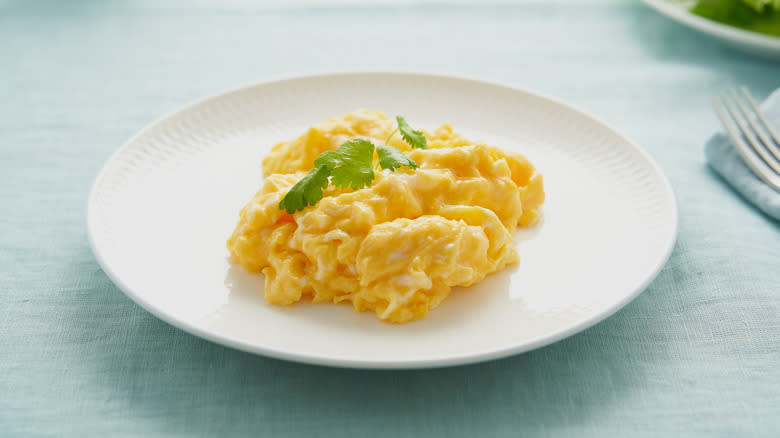
There is nothing unusual about having orange juice and scrambled eggs for breakfast, but orange juice in scrambled eggs? That could raise some eyebrows. If you served the dish without telling anyone about the strange combination, however, you're more likely to be met with showers of praise for your cooking skills than consternation at your creative flavor pairings. That's because orange juice might just be the secret ingredient that your scrambled egg recipe has been missing.
From purely a chemistry perspective, orange juice is a game-changing ingredient. Like water, it turns into steam when cooked, expanding between the strands of amino acids in the eggs and preventing them from forming a tough, rubbery matrix of proteins. As a result, your scramble will be light and fluffy with just the right amount of moisture. Then, there's the color. Orange juice is, as its name suggests, vibrantly orange. When you add it to scrambled eggs, the juice lends a depth of color that makes the dish look lusciously rich and nutritious. It will also add a hint of sweetness, which, although it may not seem like an asset, provides a pleasant flavor balance that you'll need to taste to fully appreciate.
Make Orange Syrup
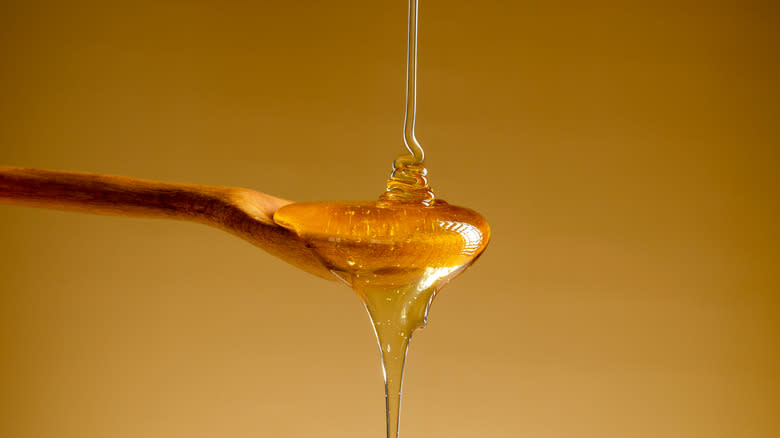
Sugar syrup (also known as simple syrup) is used in a wide variety of culinary settings, stepping in as a sweetener in cocktails or a simple glaze on cakes and pastries. It provides a glistening sheen of sweetness without the gritty texture of sugar granules and is easy to make at home. When you want something with a little more flavor, however, there are many ways to infuse sugar syrup to keep it far from simple. Whether you're opting for pineapple rinds or going all out with a recipe for elderflower cordial, it's easy to enhance the sugar and water formula to produce something special.
Orange juice is one of the best options both from the standpoint of convenience (just add a little sugar and simmer until the sugar is dissolved and the liquid has thickened) and flavor. The citrusy sweetness of the vibrant fruit can make almost any dish more delicious. You can drizzle it over everything from meat to ice cream and immediately transform a meal into something sophisticated yet broadly appealing. Where lemon juice can pack too much of an acidic edge and pure sugar syrup can be one-dimensional, orange syrup provides a hint of flavor that complements a wide range of recipes.
Make Ceviche
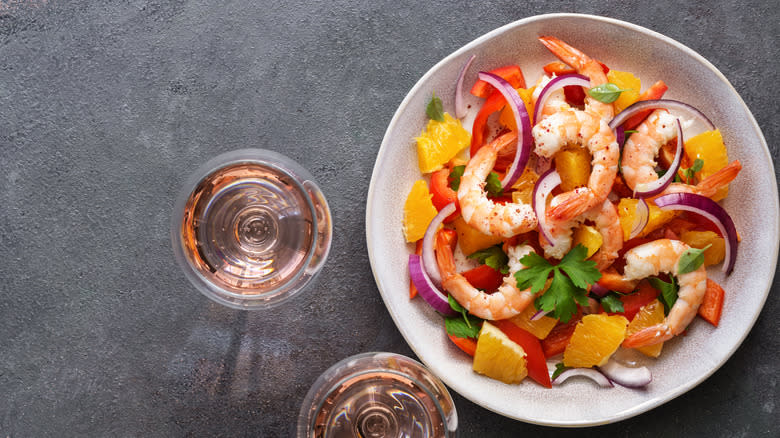
Ceviche is a traditional South American delicacy made of seafood marinated in citrus juice. Although it is often referred to as a raw dish, this isn't strictly accurate. The acid from the citrus rearranges the protein in the seafood in a process called denaturing. Although it does not involve heat, it results in a similar texture and structure as cooking achieves, turning the transparent flesh of the seafood opaque and even making it tough and chewy if the protein is left to marinate for too long.
This might sound like a complicated process that is reserved for professional chefs working in exclusive restaurants, but as long as you follow a good recipe and use high-quality ingredients, you'll find that making ceviche is much simpler than it looks. Our simple ceviche recipe uses the marked acidity and fresh flavor of lime juice but adds the sweetness and light tang of orange juice. The recipe also calls for mirin, a sweet Japanese rice wine, as well as soy sauce. If you're looking for something that's a bit outside the box when it comes to using leftover orange juice, ceviche should be at the top of the list.
Make Orange Butter
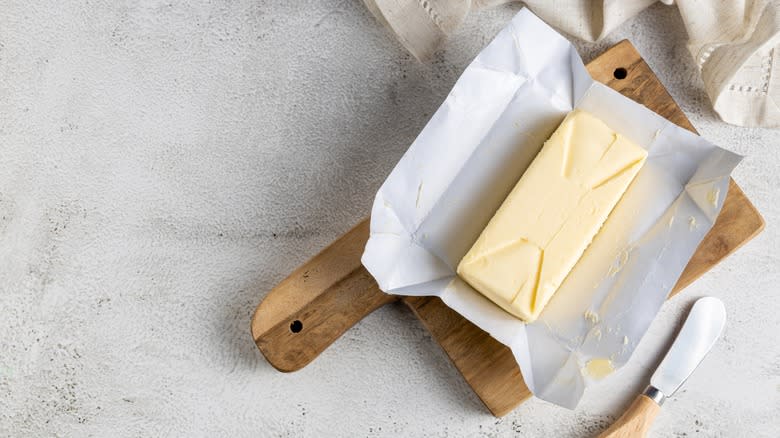
Some culinary hacks seem so obvious in retrospect that it's hard to believe they aren't already trending on TikTok or haven't yet become a treasured piece of family wisdom that's been passed down through generations. So, we don't want to overstate the utility, ease, and deliciousness of orange butter, but once you make it, you'll see that it's difficult to exaggerate just how much of a game-changer it is. Instead of having to grab butter and jam when you want a piece of toast, you just need this butter. And instead of needing two knives to avoid cross-contaminating your condiments, you will just need one. Making orange butter will enhance the flavor of many of your meals and streamline your cooking. Perhaps the best part is that it's really easy to make.
All you have to do to make orange butter is combine six tablespoons of softened butter with one to two tablespoons of orange juice (depending on your preferred consistency). Whip them in a stand mixer until they're smooth, then transfer the mixture to a jar. It can be used in a wide variety of dishes, but if you want a version that's a little sweeter, add some confectioners' sugar to your taste. If you want something more savory, you can turn this mixture into an orange butter sauce by heating the juice and butter in a saucepan with a little white wine, shallots, salt, and pepper.
Add It To Yeasted Breads

Substituting orange juice for milk in cakes and quick breads is standard practice, but a lesser-known option is to swap it with some of the water in yeast-based breads. This might fill some bakers with panic since yeast breads are notoriously delicate and can take many attempts to master. But when it comes down to it, orange juice is just a sweeter, lightly acidic version of water, and its inclusion likely will not make the difference between a flat loaf and a lofty one. Instead, it will add a pleasant, golden hue to the loaf along with a gentle sweetness. It won't transform the flavor to the same degree that a healthy dose of orange zest would, but it's an easy way to upgrade your bread recipe and use up leftover orange juice in the process.
If you're using yeast that needs to be activated in liquid before being added to the other ingredients, you'll still need to use water for this step to avoid killing the fragile yeast with acidic orange juice. However, you should be able to safely swap the rest of the prescribed liquid with orange juice.
Use It To Steam Rice
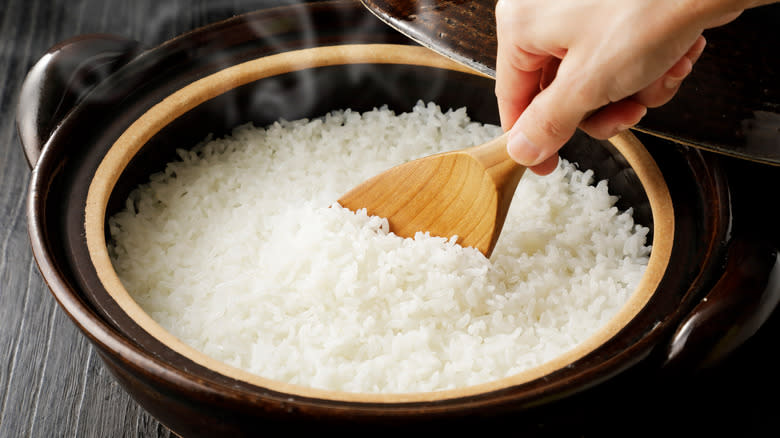
To get rid of several cups of leftover orange juice in one go without having to execute an elaborate recipe, the answer is simple: use it to steam rice. Most types of rice require a two-to-one liquid-to-rice ratio, so you might be able to empty an entire carton of unused juice if you're cooking several portions. To avoid ending up with overly sweet rice, make sure you're using unsweetened juice or cut it with 25% water.
Orange rice can be used just like plain rice. It tastes delicious with seafood, tofu, or on its own as a side dish, especially when garnished with fresh herbs like parsley and thyme. If you're making a stir-fry with chicken, garlic, onions, and veggies, it provides a lightly sweet, gently acidic edge that will elevate the dish to heights it could only reach if you'd marinated the chicken before cooking. On the flip side, it also enhances the flavor of rice pudding, adding a deliciously fruity note to the starchy creaminess. To enhance the acidic, zesty nature of sweet or savory orange rice dishes, add a teaspoon of grated orange zest.
Make Crepes Suzette
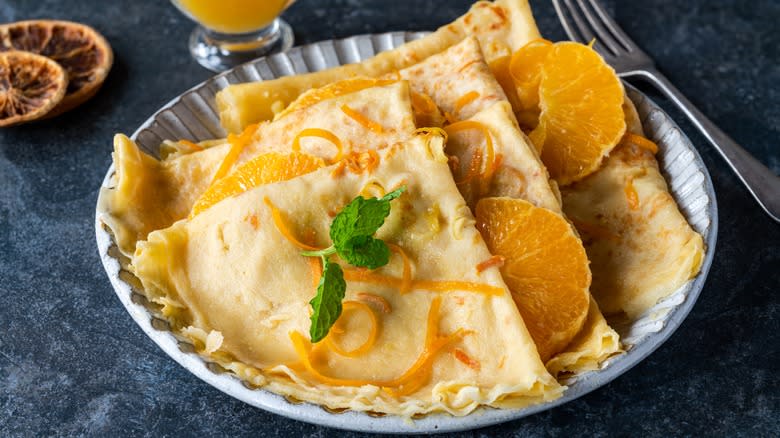
Americans have gleefully adopted many French dishes over the years, such as quiche and French onion soup, but our loyalty to thick, fluffy pancakes has left crêpes and all its variations something of a neglected culinary area. If you're trying to use up orange juice, however, crêpes Suzette is worth looking into. Since the sugary dish is usually served as a dessert rather than a breakfast food, making it will not call your allegiance to American-style pancakes into question.
Made by dousing plain crepes in a sweet sauce of orange juice, caramel, butter, and Grand Marnier, crêpes Suzette is a decadent treat for those with a sweet tooth. It's usually flambéed in restaurants thanks to the alcohol, but home cooks might prefer to keep things flame-free to avoid an unfortunate run-in with the fire alarm. Although the recipe doesn't call for much orange juice, it's a unique dessert option that will surprise and delight your dinner guests.
Use It To Glaze Bacon
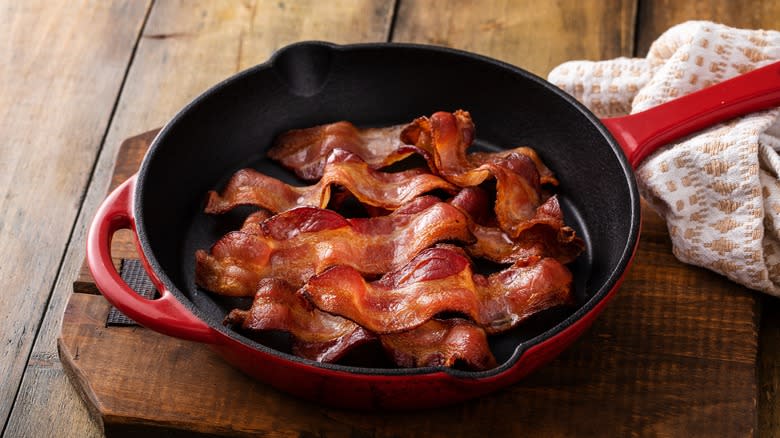
If you're the kind of person who delights in dipping their bacon in maple syrup, glazing those crispy strips of pork is the solution to a problem you didn't even know you had. You could do it with maple syrup, of course, but for something a little more novel, orange juice is an excellent option that still keeps things within the realm of familiar breakfast flavors.
The simplest version of orange glazed bacon is to heat orange juice and sugar in a saucepan until the sugar is dissolved and the liquid has thickened into a syrup. You can also use honey if you prefer a slightly more nuanced flavor. When the bacon is half-cooked, drizzle the glaze over each side as you turn them (using an oven baking method will help you avoid nasty oil splatters here). For more flavor, add whatever ingredients to the glaze you'd like. If you need ideas, Dijon mustard will add a spicy, savory edge, while orange zest will lend more citrus character to the proceedings. Brown sugar will give the bacon a stronger caramel flavor, while maple syrup will round out a trio of classic breakfast flavors.
Make Orange Curd
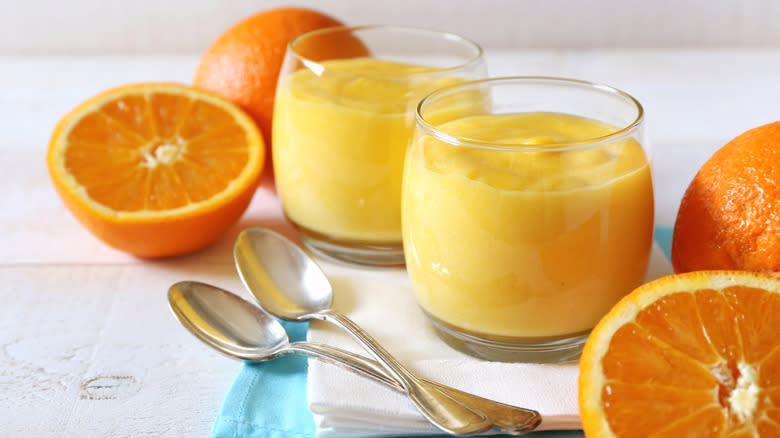
Lemon curd is used in everything from lemon tarts to donuts and is a delicious alternative to butter and jam. Although it requires patience, careful timing, and a little bit of finesse to avoid ending up with scrambled eggs instead of a smooth, sweet, velvety spread, it's surprisingly easy to make so long as you follow the recipe carefully. Luckily, once you master lemon curd, orange curd is made with the same formula but with the juice and zest of orange instead of lemon. If you're adapting a lemon curd recipe, however, make sure to ease back on the sugar since orange juice contains more sweetness than lemon juice. The result has a more vibrant hue and a softer, less tangy flavor than lemon curd, making it a perfect swap for those who prefer fruity flavors over tart ones.
You can use orange curd in a dizzying number of ways. For a quick upgrade to a piece of toast, use it in place of butter and jam. Add it to plain yogurt to make a sweet, citrusy breakfast, or fill premade tart shells for a quick yet elegant dessert.
Read the original article on Mashed.